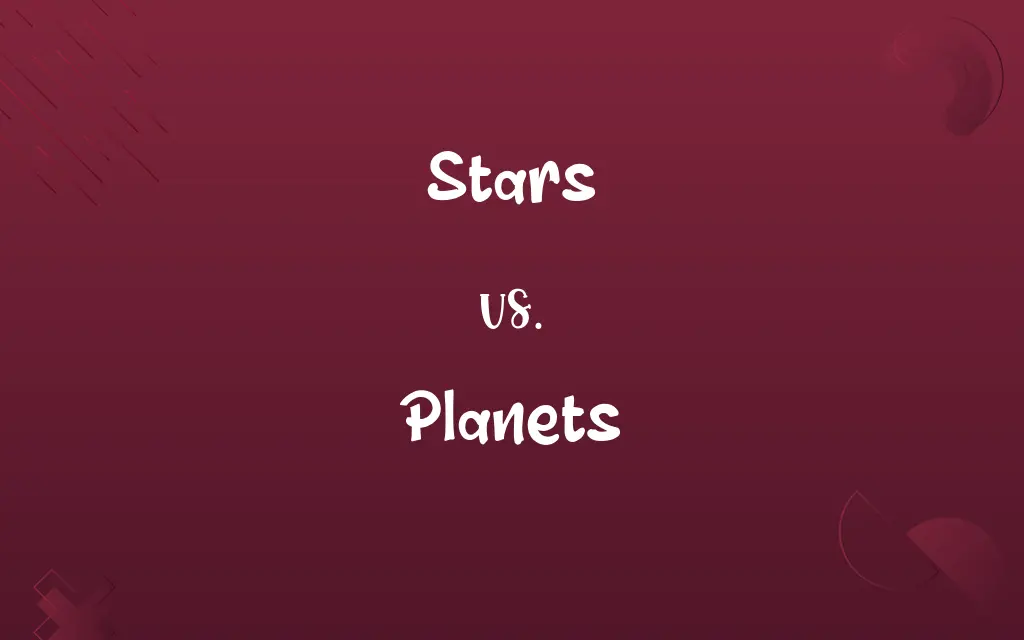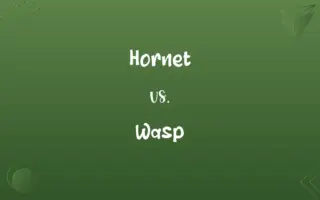Stars vs. Planets: Know the Difference

By Shumaila Saeed || Updated on December 25, 2023
Stars are luminous celestial bodies made of plasma that produce their own light and heat, while planets are celestial bodies that orbit stars and do not emit their own light.

Key Differences
Stars are massive celestial bodies composed primarily of hydrogen and helium, undergoing nuclear fusion to emit light and heat. Planets, in contrast, are smaller celestial bodies orbiting stars, reflecting the star's light rather than generating their own.
Shumaila Saeed
Nov 15, 2023
Stars are often at the center of solar systems, serving as the primary light and heat source for surrounding planets. Planets, on the other hand, do not have sufficient mass to initiate nuclear fusion, making them non-luminous.
Shumaila Saeed
Nov 15, 2023
The life cycle of a star includes stages like nebula, main sequence, and eventual transition into a red giant or supernova. Planets remain relatively stable in their orbits, with changes primarily in their atmospheres or surfaces.
Shumaila Saeed
Nov 15, 2023
Stars can vary enormously in size, composition, and temperature, with types including red dwarfs, giants, and supergiants. Planets are classified into categories like terrestrial, gas giants, and ice giants, based on composition and size.
Shumaila Saeed
Nov 15, 2023
Stars are responsible for creating and dispersing many of the heavier elements in the universe through nuclear fusion and supernova explosions. Planets are formed from the accretion of matter in a star's orbit, including these heavier elements.
Shumaila Saeed
Nov 15, 2023
ADVERTISEMENT
Comparison Chart
Composition
Mostly hydrogen and helium, with plasma.
Various, including rocks, gases, and ices.
Shumaila Saeed
Nov 15, 2023
Light Emission
Produce their own light and heat through nuclear fusion.
Do not emit light; reflect light from their star.
Shumaila Saeed
Nov 15, 2023
Role in Solar System
Central body, providing light and heat.
Orbit stars, receiving light and heat.
Shumaila Saeed
Nov 15, 2023
Lifecycle
Have stages like main sequence, red giant, supernova.
Relatively stable, with changes mainly in atmosphere/surface.
Shumaila Saeed
Nov 15, 2023
Types/Classification
Red dwarfs, giants, supergiants, etc.
Terrestrial, gas giants, ice giants, etc.
Shumaila Saeed
Nov 15, 2023
ADVERTISEMENT
Stars and Planets Definitions
Stars
Creators of heavier elements in the universe.
Stars are responsible for the creation of elements like carbon and iron.
Shumaila Saeed
Nov 15, 2023
Planets
Celestial bodies orbiting stars, reflecting their light.
Earth is the third planet from the Sun.
Shumaila Saeed
Nov 15, 2023
Stars
Celestial bodies made of plasma emitting light and heat.
The Sun is the closest star to Earth.
Shumaila Saeed
Nov 15, 2023
Planets
Bodies that do not produce their own light or heat.
Planets are illuminated by the light of their central star.
Shumaila Saeed
Nov 15, 2023
Stars
Objects undergoing nuclear fusion to produce energy.
Massive stars burn hotter and have shorter lifespans.
Shumaila Saeed
Nov 15, 2023
ADVERTISEMENT
Planets
Classified as terrestrial, gas giants, or ice giants.
Neptune is classified as an ice giant due to its composition.
Shumaila Saeed
Nov 15, 2023
Stars
A celestial body that generates light and other radiant energy and consists of a mass of gas held together by its own gravity in which the energy generated by nuclear reactions in the interior is balanced by the outflow of energy to the surface, and the inward-directed gravitational forces are balanced by the outward-directed gas and radiation pressures.
Shumaila Saeed
Oct 19, 2023
Planets
Bodies that have cleared their orbit of other debris.
Planets form by accreting matter from a star's protoplanetary disk.
Shumaila Saeed
Nov 15, 2023
Stars
Any of the celestial bodies visible at night from Earth as relatively stationary, usually twinkling points of light.
Shumaila Saeed
Oct 19, 2023
Planets
Objects with sufficient mass for a nearly round shape.
Jupiter is the largest planet in our solar system.
Shumaila Saeed
Nov 15, 2023
Planets
In the traditional model of solar systems, a celestial body larger than an asteroid or comet, illuminated by light from a star, such as the sun, around which it revolves.
Shumaila Saeed
Oct 19, 2023
Stars
A graphic design having five or more radiating points, often used as a symbol of rank or merit.
Shumaila Saeed
Oct 19, 2023
Planets
A celestial body that orbits the sun, has sufficient mass to assume nearly a round shape, clears out dust and debris from the neighborhood around its orbit, and is not a satellite of another planet.
Shumaila Saeed
Oct 19, 2023
Stars
An artistic performer or athlete whose leading role or superior performance is acknowledged.
Shumaila Saeed
Oct 19, 2023
Planets
One of the seven celestial bodies, Mercury, Venus, the moon, the sun, Mars, Jupiter, and Saturn, visible to the naked eye and thought by ancient astronomers to revolve in the heavens about a fixed Earth and among fixed stars.
Shumaila Saeed
Oct 19, 2023
Planets
The collection of life forms supported on Earth
An asteroid that threatened the whole planet.
Shumaila Saeed
Oct 19, 2023
Planets
People as a whole; humankind or the general public
The entire planet was affected by the global recession.
Shumaila Saeed
Oct 19, 2023
Planets
One of the seven revolving astrological celestial bodies that in conjunction with the stars are believed to influence human affairs and personalities.
Shumaila Saeed
Oct 19, 2023
Stars
A planet or constellation of the zodiac believed in astrology to influence personal destiny.
Shumaila Saeed
Oct 19, 2023
Stars
Outstanding or famous, especially in performing something
A star researcher.
A star figure skater.
Shumaila Saeed
Oct 19, 2023
Stars
Central bodies in solar systems.
Every star has the potential to host its own solar system.
Shumaila Saeed
Nov 15, 2023
Stars
Luminous points in the night sky visible from Earth.
Ancient navigators used stars to guide their way.
Shumaila Saeed
Nov 15, 2023
Repeatedly Asked Queries
Are all stars the same color?
No, stars vary in color based on temperature, from red to blue.
Shumaila Saeed
Nov 15, 2023
How long does a star live?
It varies; smaller stars live longer, while massive stars have shorter lifespans.
Shumaila Saeed
Nov 15, 2023
Do stars have seasons?
No, seasons are a phenomenon specific to planets with tilted axes.
Shumaila Saeed
Nov 15, 2023
Are all planets made of rock?
No, some are gas giants like Jupiter, while others are rocky.
Shumaila Saeed
Nov 15, 2023
Can planets support life?
Earth supports life, and other planets may potentially support life under certain conditions.
Shumaila Saeed
Nov 15, 2023
What defines a planet's orbit?
A planet's orbit is defined by its gravitational interaction with its star.
Shumaila Saeed
Nov 15, 2023
Do all planets have atmospheres?
Many do, but their compositions vary greatly.
Shumaila Saeed
Nov 15, 2023
Can planets have their own moons?
Yes, many planets, like Earth, have one or more moons.
Shumaila Saeed
Nov 15, 2023
Do stars move in the sky?
They appear to move due to Earth's rotation but are relatively fixed in their positions.
Shumaila Saeed
Nov 15, 2023
Are stars always visible at night?
Mostly, but factors like light pollution and clouds can affect visibility.
Shumaila Saeed
Nov 15, 2023
Can planets be larger than stars?
Generally, no. Stars are typically much larger than planets.
Shumaila Saeed
Nov 15, 2023
Can we see all stars with the naked eye?
No, many stars are too far or too faint to be seen without a telescope.
Shumaila Saeed
Nov 15, 2023
Are there planets without stars?
There are rogue planets that do not orbit any star.
Shumaila Saeed
Nov 15, 2023
Do planets have different day lengths?
Yes, the length of a day varies based on the planet's rotation speed.
Shumaila Saeed
Nov 15, 2023
Do planets emit light?
Planets do not emit their own light but reflect light from their stars.
Shumaila Saeed
Nov 15, 2023
Can planets collide?
While rare, planetary collisions can occur during solar system formation.
Shumaila Saeed
Nov 15, 2023
Is the Sun the only star with planets?
No, many stars have been found to have their own planets.
Shumaila Saeed
Nov 15, 2023
Share this page
Link for your blog / website
HTML
Link to share via messenger
About Author
Written by
Shumaila SaeedShumaila Saeed, an expert content creator with 6 years of experience, specializes in distilling complex topics into easily digestible comparisons, shining a light on the nuances that both inform and educate readers with clarity and accuracy.








































































